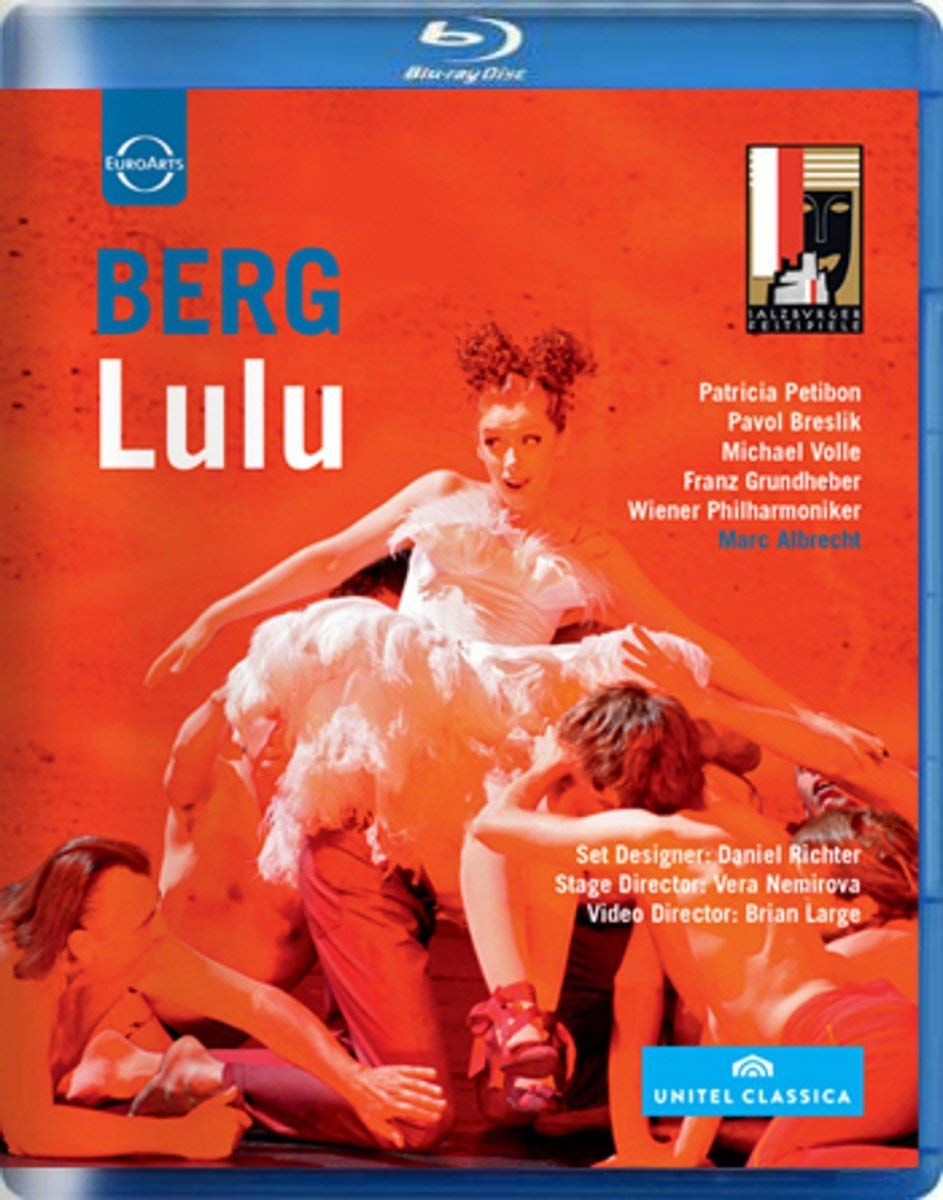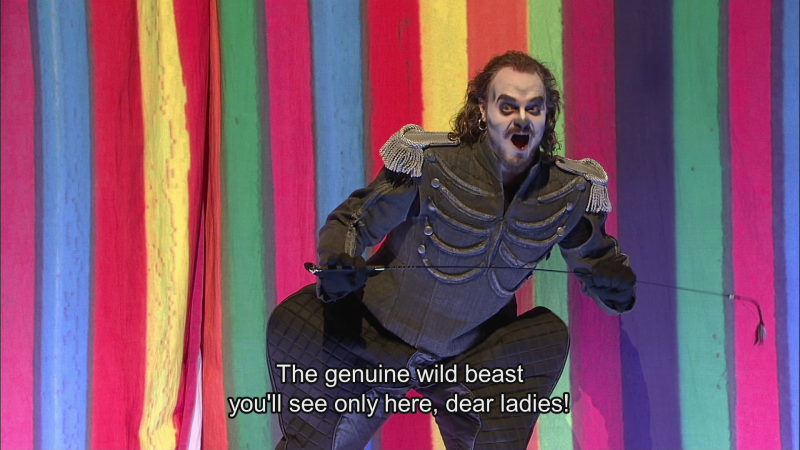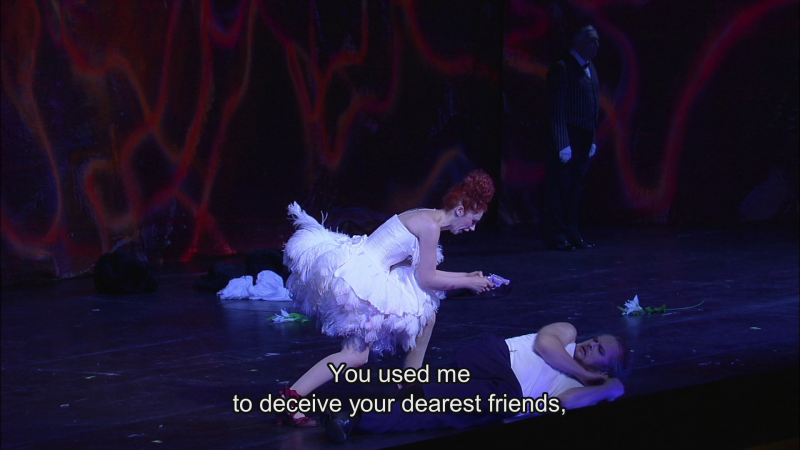

Alan Berg Lulu opera to libretto by the composer (3-act version completed by Friedrich Cerha in 1979). Directed 2010 by Vera Nemirova at the Salzburg Festival (Haus für Mozart). Stars Patricia Petibon (Lulu), Michael Volle (Dr. Schön/Jack the Ripper), Thomas Piffka (Alwa), Tanja Ariane Baumgartner (Countess Geschwitz), Cora Burggraaf (Theatrical Dresser/High-school Boy/Groom), Pavol Breslik (Painter/Negro), Franz Grundheber (Schigolch), Thomas Johannes Mayer (Animal Taimer/Rodrigo, an Athlete), Heinz Zednik (Prince/Manservant), Andreas Conrad (Marquis), Martin Tzonev (Theater Manager/Banker), Emilie Pictet (Fifteen-year-old Girl), and Cornelia Wulkopf (Mother of Girl). Marc Albrecht conducts the Vienna Philharmonic. Sets by Daniel Richter; costumes by Klaus Noack; lighting design by Manfried Voss; dramatic advisory by Sonja Nemirova and Jens Schroth. Directed for TV by Brian Large. Sung in German. Released 2012, disc has 5.1 dts-HD Master Audio sound.
This is the same recording as a Kultur Lulu also released 2012 for Region A only. This Euroarts release is for Regions B and C; on the package, it calls this "Region Code 2-6 (worldwide excl. USA & Canada)." So it seems that Kultur and EuroArts have a contract dividing up the world into two markets for this title. But when I put the EuroArts disc in my Region A Oppo 93, it plays fine! Zoltan Glied also confirmed this on two Region A players. EuroArts is known for shabby quality control; this time the sloppiness works in the customer's favor.
In the January, 2013 Opera News (page 59) subject title Lulu was praised as a "2012 Favorite" title. The EuroArts version has a decent keepcase booklet; the Kultur package has none. The Kultur version has only Dolby 5.0 sound. Finally, the EuroArts disc has German subtitles, but the Kultur does not. Because of the better sound spec, the nicer presentation, and the better subtitles, I grade this version A and give a B to the Kultur disc. But caution: one of these days EuroArts could change the disc to block Region A players. Grade: A
Lulu in its Cerha version was first performed in 1979. It a long, complicated, and sophisticated work with challenging modern music. Someone said an opera is a play where people sing about sex and violence. That definition fits—s Lulu. But this is not in another sense a normal opera, which usually has a cast of characters (included at least one you care about), a conflict, a climax, and an happy or sad ending. Lulu has a lot of characters, and you don't care about any of them. Instead of a conflict/climax/resolution there is a long string of disasters. But is still fascinating to see how most everybody comes to ruin.
Well, if you were to care about any character in this opera, it would be Lulu. She was abused as a child by her mysterious father Schigolch and by Dr. Schön, who took her off the streets at age 12 as a protégé and target of opportunity. The abuse set her on a path of amorality and promiscuousness that eventually led to her death. Along the way Dr. Schön, his wife, and his son are all murdered and a number of other people also die before their time. But I don't think this opera is really about a ruined girl---to me it's a satire (somewhere between morbid and mordant) in which Berg skewers just about everything, including Lulu the opera itself.
S—So now you maybe get the picture: this is a comedy. From what I can tell from recordings, people don't laugh at this in the opera house. But in a home theater, with good subtitles you get how clever and sarcastic the libretto is. I laugh at this a lot, and loud! If I did this in a theater, somebody might glare at me or tap me on the shoulder. But at home I can laugh all I want.
Veri Nemirova is quite successful at Salzburg in supporting the singing and acting with sets, costumes, and props that help make sense of the dense libretto. A newcomer to the opera with the aid of a synopsis has a fighting chance of following the pageant of calamities. Taking mercy on the viewer, Nemirova avoids injecting surreal or baffling elements in the show. Then "Large takes charge" to give the home viewer a dazzling video with superb picture quality and picture content.
Maybe the most confusing part of this opera is Act II, scene 1, after Dr. Schön marries Lulu and his home life disintegrates into chaos. Nemirova manages with the use of skillful visual images to get me through this. I also like the way Nemirova and Large stage the Act III, scene 1 Paris party scene by putting it 98% in the midst of the audience. It took a lot of nerve and skill to bring this off, and this change of approach helps avoid the onset of monotony in this long opera.
Lulu begins with a prologue from the animal tamer (Thomas Johannes Mayer) that warns the faint-at-heart to steel themselves for what is to come:
Meet Lulu (Patricia Petibon) and her father (Franz Grundheber), which whom she has an odd relationship:
Lulu is married to Dr. Goll (uncredited mute role). Lulu is having some fun with a fine-arts painter (Pavol Breslik) who is doing her portrait. Suddenly Dr. Goll appears and catches them at it.
Outraged, it appears Dr. Goll will beat Lulu. But he is suddenly felled by a heart attack and dies. Lulu tries to revive Dr. Goll. When she realizes he is dead, she says in astonishment, "Now I'm rich!"
Lulu is physically and mentally nimble. Already she has formed a plan to marry the painter. I admire this image for its contrast of Lulu's red hair and the lurid blue and green background:
Lulu puts Goll's ring on the painter's finger. This gesture seals his doom:
The painter marries Lulu. But about a year later he learns many of the sordid details of Lulu background, which Lulu had obscured from him with a web of lies. The painter cuts his throat. Here Lulu is stripping the ring off the painter's finger:
Now we meet Dr. Schön (means "pretty" in German), the man who fell in love with Lulu when he met her at age 12 (she was selling roses at a night club). (Schön is played by Michael Volle.) He is distressed that Lulu has survived two husbands in a couple of years. He wanted her to stay married to help him find a new and more conventional lover. But now Lulu has made up her mind again—she wants the man who has been her only solace since she was 12:
Lulu knows her power over men, including Schön:
After a huge battle, Schön caves in. Lulu puts the ring on his finger to seal the deal:
Lulu and Schön marry. Soon the Schön home is besieged by his wife's many admirers. One of them is Countess Geschwitz (Tanja Ariane Baumgartner), a lesbian who will remain obsessed with Lulu for the rest of Lulu's life:
Tension mounts until Schön gives Lulu a gun and orders her to kill herself. But Lulu is not about to do that:
Instead she shoots Schön (probably manslaughter rather than intentional murder):
Geschwitz is a witness to the death of Lulu's third husband. Now we have an image of a woman in green against a background of red---the opposite of the image above with Lulu in red against a green background. And this time it's Geschwitz who is determined. Since Lulu can't stay married to a man, she needs to become the wife of Geschwitz:
But Lulu votes for men. Now we meet Alwa, Schön's son and sort-of-brother to Lulu. They are strongly attracted to each other now and this will last until the night when both of them will be murdered.
Lulu rewards Alwa's devotion with a small confession:
Lulu is arrested for Schön's death and draws a prison sentence. She deliberately contracts Cholera so as to get a hospital stay. Geschwitz, forever loyal, is suddenly inspired with by a plan to get Lulu out of the hospital:
And the plot works:
Now we are up to Act III, where the satire turns from sex and mores more to business and society. This image show the audience milling about. And about 20 members from the cast have also infiltrated the crowd:
It's hard to distinguish between the cast and the audience. It took a lot of guts to mix it up this way and was doubtless very tricky to record for picture and sound:
Now Lulu and her entourage are suddenly rich again thanks to a stock market royal flush. In this picture, the bald man in the white dinner jacket and the lady dressed in the cheetah pattern (and her escort) are members of the audience. The others standing are cast members, including one doubling as a usher:
After wild celebration and the addition of several new plot elements, we have a stock market crash which utterly wipes out Lulu and her friends:
In this astonishingly devastating picture, Lulu is starting her career as streetwalker. Her first client is played by the same mute actor who played Dr. Goll:
Her second client is played by Pavol Breslik, the same actor who also was the painter, Lulu's second husband:
And Michael Volle (third and last husband) plays the role of Jack the Ripper (third and last client). After some difficult negotiations with the third client, Lulu forms a new ambition. She will go back home, finish her prision sentence, and then:
But within 15 seconds she will be dead:
OR


























